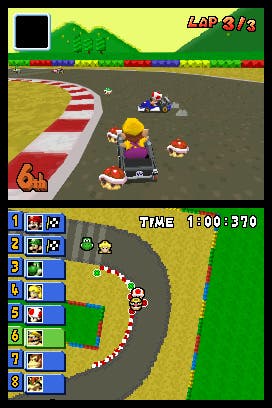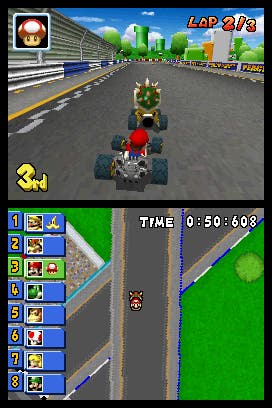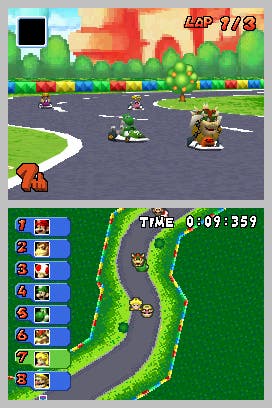Mario Kart DS
The answer to 'Wi-Fi?'
Ah, Mario Kart. You don't even need to describe the basics.
(Since I'm paid to though: eight go-karting characters from Mario's world dart around themed tracks for three laps, collecting power-ups and projectiles from question-mark blocks and doing unspeakably cruel things to one another with them; the controls are superb and the intuitive power-sliding system superbly judged; and there's a multiplayer power-up-focused arena mode which remains one of the few games my sister will agree to play with me as we sit there in the lounge on Christmas Day staring down the Queen's speech and wishing we'd eaten less chocolate.)
I still think back to the way the sliding worked in Super Mario Kart and marvel at it in my head. It was a show-off move, a boost and an evasion tactic rolled into one - it was one of my first experiences of leaning into the corners with a racing game, and as you realised you were on collision course with something unavoidable, a hop-and-turn threw you to one side, screeching across the racing line like a surfer dodging a shark. (Presumably. My surfing experience is pretty much limited to the sort that led me to wind up here. That and Home & Away.) Mario Kart DS is closer to Mario Kart 64 in its approach to sliding - it doesn't whip you out to one side quite as much when you start, but when you throw yourself into a turn with enough drifting room to push away from the curb and into it again twice before running off-track, and you gain a red-sparked boost. Most of the new tracks seem purpose-built to be taken advantage of in this manner.
Mind you, even I, the chap who famously loved Mario Kart: Double Dash like a child when most of the other critics decided to hate it, have to confess that conquering single-player Mario Kart has become more of an unshakable habit than a true delight. My pleasures and pains haven't diverged greatly from the ones I experienced as a skiving teenager pretending to do my homework but invariably playing Super Mario Kart instead. A finely timed red shell that robs a computer counterpart of a podium position still excites, an elastic adversary's last-minute success still makes me want to rip the cartridge in half and snarl at its innards.

The quality of track design and the intense joy of success fuel a determination to keep going, and there are new joys here too - like holding an enemy's slipstream long enough to gain a momentary boost - but there is also a certain amount to criticise. The divide between success and failure is all too often bridged by chance and the side of the bed the AI woke up on that day. It ought to be measured in skill. As with previous Mario Karts, you'll heap much of the resultant hate upon your recognisable opponents and their cheating ways - the enduring breadth and depth of Mario's character-base means that you can hate Princess, Yoshi or Bowser and wish a pox upon them instead of turning the DS around, lifting out the game card and actually cursing its children. But yes, it's far from perfect. There's one positive introduction, mind - not the aforementioned slipstreaming, which is a likable inclusion (not exactly new, but polished and implemented excellently), but the game's Mission mode, which deserves its own paragraph.
It is, I'm reliably informed, fun on trains. Since I usually sit there trying not to make eye contact with people, or consciously starving and yet too polite to rip open my bag of crisps and ruin the ambience of the "Quiet Zone" with my crunching and crinkling, I really can't comment on that, but the missions certainly offer something different. Collecting X amount of coins within a time limit, breaking open X boxes, scoring three shell-hits on the eyeballs of a pair of giant slapping hands - to start with it feels awkward, an aberration, but its compulsive quality quickly becomes apparent.
As for multiplayer Mario Kart, it remains something quite exceptional, and transferred to the DS ("reborn on" would be pushing it), it's grown into that rarest of things: a handheld game that people will genuinely spend more time playing with others than alone. You can race and battle with up to seven friends using one game card - your opponents are limited to using one character, but you have eight racing tracks and three arenas to take on in two battle modes. You can even play the battle modes against AI opposition, although it's a rather soulless experience when you can't laugh in their actual faces afterward.

Battling with real people is available in balloon and Shine modes. Shine mode involves collecting scattered stars and trying to hold onto them as your friends pelt you with projectiles, the winner being the fellow with the most when the clock runs down. Balloon mode, as is tradition, is about popping others' balloons with power-ups. But, ah! Here you start with one, and four in reserve, and you blow up auxiliary balloons by finding a quiet spot and then blowing into the microphone, for a maximum of three spinning round you at once. Of course, in a decent battle-mode game, a quiet spot's about as easy to find as a pub that serves Coke and Pepsi, which adds another layer of skill to an already frantic little multiplayer game.
Annoyingly though, the arenas themselves are a bit bland and limited. The cake one, with a giant boost-pad-iced cake in the centre, is just a big circle and the centre section sparks too much easy evasion. The one set on top of a Nintendo DS console in space is similarly open. The multi-layered block arena dragged back from the N64 is welcome, but it seems odd that while the original SNES game had four arenas that were almost uniformly excellent, Nintendo still struggles with its modern updates. Another criticism is that you can't do this bit online - that would have sealed Mario Kart an even higher mark.
As it stands though, it edges into one anyway because the game's vaunted online system, Wi-Fi Connection, is marvellous.
Assuming, that is, you get beyond the initial stage of setting it up. I had all manner of difficulties finding an access point that would let me share my skills with the outside world - my own wireless Actiontec router, firmware upgraded and every last tech-support comment on Nintendo's website taken into consideration, stubbornly refused to play ball even when I reset everything and turned my building's hallway into Pimlico's cheapest Internet café.

But once you get it going, whether by not owning an incompetent router, by purchasing Nintendo's USB dongle, or by finding a public hotspot, it's a breeze. It's just a shame Nintendo's charging 30 bob for the dongle. You can gather opponents by world, continent, friends or skill, and although the friend codes the game spits out are unwieldy numbers, once you've plugged them into memory you never have to think about it again. Venture online and you can suddenly engage in races against Princesses, Yoshis and Bowsers who aren't cheating to keep up with you! Mario Kart's accessibility, gently concealed depths and sheer popularity guarantee a suitable field of opposition pretty much any time of day, and while they visibly jerk around from time to time, and there are a couple of concessions to potential lag in the power-up systems (dragging a shell behind you doesn't seem to work, for instance), it doesn't affect your race, and so it works. Waking up on a friend's couch last week, I decided it was much too cold to make for the bathroom, grabbed the DS from my jacket pocket and hid under a mountain of cushions spanking Americans.
When you lose, you can switch off, turn it back on again and sulk while you pummel your favourite tracks in Time Trial mode or try to unlock secret characters and new karts in the single-player modes. It won't take you forever to collect everything, but getting those top ranks and dispatching the mirrored 150cc racing class at the end of it all is certainly more than a frenzied weekend's play away, whatever your karting credentials.
Some will feel a little short-changed to discover that half the game is made up of tracks from the games you already own, but there are few weak links in the four cups of new material. There are several genuinely memorable additions - Fortress Airship, based on the airships from Mario Bros. 3, Cheep Cheep Beach, the new Wario Stadium with its various ramps and bumps, Bowser Castle with its rotating cylindrical walkway, moving ramps and turntable, Princess's castle garden with its bow-ows and flower-bed obstacles. Ok, so the weakest are really weak - the figure-of-eight circuit is rubbish, and the ticking clock level, despite a decent concept, just bores - but there's far more good than bad. The retro cup selections are mostly laudable, too - Mario Circuit 1, Donut Plains 1, Yoshi Circuit from Double Dash, that bastard Sky Garden effort from the GBA's Super Circuit... The only real pity is that the new Rainbow Road lacks the sense of danger and surprise that it used to have.

Veterans might also complain about the lack of truly new power-ups, and moan that more than with any other series Nintendo goes against type by recycling so much with each new Mario Kart, but the majority will care not for their black-hearted protestations because the multiplayer racing model remains fundamentally unbroken. Meanwhile, the addition of the second screen means you can actually watch the bouncing shell projectiles across the track from above, and keep an eye on who has which power-up. You'll never need a stylus, but you'll love that second screen when you're pushing ahead in first position, someone unleashes a blue shell to take you out, and you use the second screen to judge relative positions and strategically brake and take down a pair of rivals in the unavoidable explosion.
Played alone, it's another satisfying Mario Kart game. I doubt anything will ever dislodge Super Mario Kart from the throne in my mind, but it comes close as the best of the series. But the beauty of Mario Kart DS is that it's really, genuinely practical to play with other people, wirelessly or online. There's not much more to say. Except that if the DS in Mario Kart DS stands for anything, perhaps it's "default state", because it's hard to imagine a time when I'll be reluctant to return to the multiplayer racing - and as long as there are people who feel likewise, it'll be a game that richly rewards anyone's investment.




